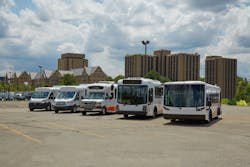In a world that is moving faster than ever before, everything that can be done to improve efficiency in products and services is essential and contributes to success. For the transit industry, this means optimal efficiency is necessary in every aspect of the ride. Multiple components and processes can be altered in order to achieve greater efficiency.
First and foremost, it is vital to have the most fitting vehicle for the application. Larger buses are quite efficient due to the greater available passenger capacity; however, if not utilized how they are intended, it is not always the best fit. If a fleet contains large buses that are not at full capacity during the route, it may be more beneficial to use a smaller bus such as a cutaway. Cutaways also tend to offer better fuel efficiency.
Utilizing low-floor buses rather than high-floor buses in a fleet has a great impact on efficiency in several areas. A problem that is frequently overlooked is the cabin temperature. An uncomfortable bus climate — whether too hot or too cold — has a poor impact on the rider’s overall experience and opinion regarding public transportation. Because of this, it is important to choose the correct heating, ventilation and air conditioning system for the bus. With the many HVAC system options available, making a decision may seem overwhelming. While there are advantages to using a rooftop system, it has been found that utilization of a split system performs much more efficiently.
Another factor in temperature efficiency is the amount of time the doors are left open. For optimal efficiency, the doors must remain closed to a feasible extent. This is difficult to accomplish using a standard-floor bus with a rear wheelchair lift, due to the time consumed loading and unloading passengers who use mobility devices. This process leaves the rear door open for up to five minutes per person, exposing the cabin to outdoor temperatures throughout that length of time and resulting in uncomfortable passengers during extremely hot or cold conditions. Utilization of a low-floor bus containing an entrance ramp makes the boarding process simple, thus remedying the issue. With a low floor, the ramp is fully deployed from the driver’s seat in only 10 seconds. The passengers enter the vehicle via the ramp, often with no assistance. Once riders have boarded, the ramp is stowed in another 10 seconds, cutting time down tremendously in comparison to a high-floor bus that requires the lift to be raised and lowered for each rider utilizing a mobility device.
Another effect of the low floor is increased efficiency in fixed-route service. With the speedy boarding process a low floor offers, route times are shortened immensely. Transit agencies across the nation have found that they are able to expand their routes using fewer buses due to the time saved by utilizing a low floor with an entrance ramp. This saves a tremendous amount of money for the agency and improves rider satisfaction, making them more likely to use public transportation in the future.
Thurston Woods Village of Sturgis, Michigan, performed a study comparing both indoor temperatures and operation speed of a low-floor bus equipped with an entry ramp versus a high-floor bus with a wheelchair lift, while boarding three passengers. The interior temperature of each bus was 72.4 degrees Fahrenheit to begin with, while the outside temperature was 91 degrees. The low-floor bus drove away after three short minutes with a cabin temperature of 75.4 degrees and three passengers using mobility devices securely on board. The high-floor bus took nearly triple the time to load the same three passengers and the indoor temperature as it departed was 84.9 degrees, almost 10 degrees higher than the low floor.
With numerous options available to meet specific transportation needs, it is important to choose a bus that will bring efficiency to the fleet. A low-floor bus featuring an entrance ramp has proven it can be revolutionary, making it an undoubtedly efficient selection.
Ami Sailor is the marketing manager at ARBOC Specialty Vehicles.




